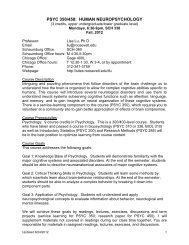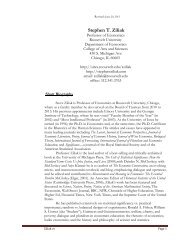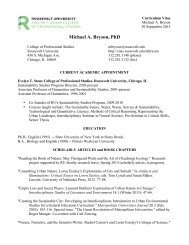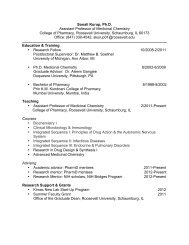Social Insurance and Public Assistance
public-assistance-welfare-reform-colonial-times-to-the-present-ziliak ...
public-assistance-welfare-reform-colonial-times-to-the-present-ziliak ...
Create successful ePaper yourself
Turn your PDF publications into a flip-book with our unique Google optimized e-Paper software.
SOCIAL WELFARE PROGRAMS Series Bf722–734 813<br />
TABLE Bf722–734 Federal employee <strong>and</strong> civil service retirement systems – annuitants: 1925–1997 Continued<br />
separation requirement for federal employees who attain age 70 was removed.<br />
In 1979, the Office of Personnel Management began to administer<br />
the program, which was replaced by a new FERS in 1987.<br />
As of 1999, almost all federal employees hired after 1983 are automatically<br />
included in the FERS program. The FERS provides three types of benefits:<br />
the basic <strong>Social</strong> Security benefits, a basic annuity component based on<br />
contributions by the employer <strong>and</strong> the government, <strong>and</strong> the opportunity to<br />
participate in a Thrift Savings Plan, which is essentially a tax-deferred savings<br />
<strong>and</strong> investment plan similar to the 401(k) for corporations. Generally, the<br />
basic annuity component of FERS is 1 percent of the employee’s “high-3”<br />
year’s average pay, multiplied by years of service. If the employee retires at<br />
age 62, or later, with at least twenty years of service, a factor of 1.1 percent is<br />
used rather than 1 percent. The tax-deferred savings plan allows employees<br />
to contribute up to 10 percent of their income. The government automatically<br />
contributes to the employee’s account an amount equal to 1 percent<br />
of basic pay, <strong>and</strong>, if the employee contributes, the government matches the<br />
contribution up to a maximum of 4 percent of the employee’s salary to the<br />
plan. A special retirement supplement designed to approximate the retiree’s<br />
eventual <strong>Social</strong> Security benefits may be provided to compensate the retiree<br />
for any lack of <strong>Social</strong> Security benefits for those retiring prior to reaching the<br />
age of 62. Retirees may be eligible for the supplement if they retired after the<br />
minimum retirement age with thirty years of service, at age 60 with twenty<br />
years of service, or upon involuntary retirement. Law enforcement officers<br />
<strong>and</strong> firefighters who retire at age 50 with twenty years of service or at any<br />
age with twenty-five years of service are also eligible for the supplement. This<br />
supplement is also payable, after attainment of the minimum retirement age,<br />
to discontinued service <strong>and</strong> involuntary retirees as well as to members of the<br />
Senior Executive Service (SES) who are removed from SES status <strong>and</strong> who<br />
retire at the age of 50 with twenty years of service or at any age with twentyfive<br />
years of service.<br />
Employees hired prior to 1984 are typically included under the CSRS, although<br />
they have the option to transfer to the FERS. Many of the features of<br />
the CSRS plans are the same as in 1973, although as of September 30, 1978,<br />
m<strong>and</strong>atory retirement was eliminated for federal employees. CSRS-covered<br />
employees may also participate in the Thrift Savings Plan, but their participation<br />
is limited to 5 percent of salary <strong>and</strong> no government contribution is<br />
made.<br />
As of 1997, there are two requirements that all retiring employees must<br />
meet for the CSRS. First, the employee must have at least five years of civilian<br />
service with the federal government. Second, unless retiring because of total<br />
disability, the employee must have been employed under the CSRS for at<br />
least one year of the last two preceding final separation. There is no “1-outof-2”<br />
requirement under FERS as there is under CSRS. Employees are eligible<br />
for immediate retirement if they meet these general requirements <strong>and</strong> any<br />
combination of the following age/service requirements. (1) Employees may<br />
elect optional voluntary early retirement, series Bf734, at a minimum age of<br />
62 with at least five years of service; at age 60 with at least twenty years of<br />
service; or at age 55 with thirty years of service. (2) Law enforcement officers<br />
may retire at age 50 with twenty years of service. (3) Employees at any<br />
age with at least twenty-five years of service may retire when the agency is<br />
undergoing a major reduction in force. In the latter category, benefits may<br />
be reduced.<br />
Series Bf722. For 1920–1979, equals the sum of series Bf723–725 <strong>and</strong><br />
Bf727–733. For 1980–1997, equals the sum of series Bf726–734.<br />
Series Bf723–726. The employees who retired under the “normal” rules are<br />
reported from 1920 to 1979 in three categories: m<strong>and</strong>atory retirement, optional<br />
retirement with thirty or more years of service, <strong>and</strong> optional retirement<br />
with less than thirty years of service. Starting with 1980, these three series<br />
were replaced by a single series for normal retirement (series Bf726). In 1979,<br />
when both sets of series were reported, series Bf723–725 summed to series<br />
Bf726. Series Bf723 ends in 1979 because the m<strong>and</strong>atory retirement age<br />
requirement was abolished.<br />
Series Bf727. Employees of any age with at least five years of service may<br />
qualify for disability retirement if they become disabled for useful <strong>and</strong> efficient<br />
service.<br />
Series Bf728. An employee who meets the five-year service requirement for<br />
retirement <strong>and</strong> who is separated from the federal service for any reason before<br />
meeting the age requirement for a general annuity may receive a deferred<br />
annuity that is payable upon attaining age 62. For 1945–1955, the information<br />
for the series was listed in the original source under the title “optional<br />
retirement with 5 years service at age 62.”<br />
Series Bf729. Employees age 50 or older with at least twenty years of service,<br />
or at any age with at least twenty-five years of service, may qualify for<br />
discontinued service retirement with a reduced annuity in cases of involuntary<br />
separation from the federal service. Involuntary separations include any<br />
separation against the will <strong>and</strong> without the consent of the employee, other<br />
than “for cause” for misconduct or delinquency. The most common cause of<br />
an involuntary separation was a reduction in force. Employees who decline<br />
“reasonable offers” of other positions are not eligible for discontinued service<br />
annuities. A reasonable offer is defined as the offer of another position<br />
in your agency <strong>and</strong> commuting area for which you are qualified <strong>and</strong> that is<br />
no more than two grades or pay levels below your current grade or pay level.<br />
Series Bf730–733. There are several categories of federal employees who operate<br />
under special retirement rules, including those under hazardous duty,<br />
air-traffic controllers, members of Congress, <strong>and</strong> annuitants who were transferred<br />
from other systems. The hazardous duty series is referred to as “law<br />
enforcement <strong>and</strong> firefighters” after 1980, but the data are comparable over<br />
time.<br />
Series Bf734. Refers to annuitants who chose voluntary early retirement.<br />
Annuitants fall under this category when they volunteer to retire when an<br />
agency undergoes a major reorganization, reduction in force, or transfer of<br />
function, <strong>and</strong> a significant percentage of the employees will be separated<br />
or reduced in pay. At that point, the head of the agency can ask the Office<br />
of Personnel Management (OPM) to permit early optional retirement<br />
for eligible employees to lessen the impact of involuntary separations <strong>and</strong><br />
demotions. After the agency head obtains approval, workers with at least<br />
twenty-five years of service, or workers at least age 50 with twenty or more<br />
years, may retire voluntarily on an immediate annuity. The annuity is reduced<br />
by 2 percent for each year younger than age 55.









